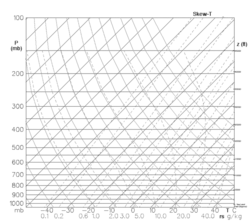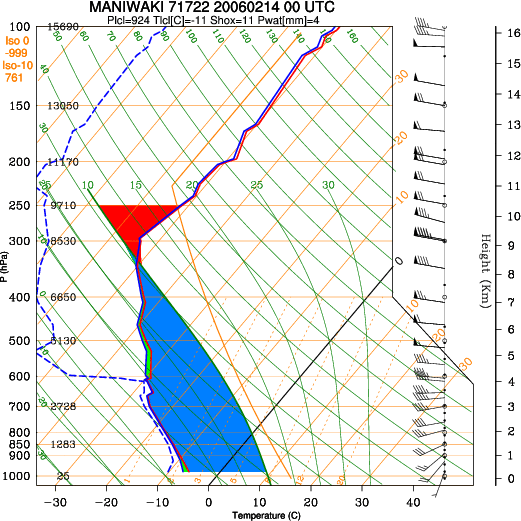Skew-T
- Skew-T
-
SkewT

* Températures à 45 degrés de la verticale
* Pressions selon les lignes pleines horizontales
* Adiabatiques sèches selon les lignes pleines courbes
* Adiabatiques humides selon les lignes pointillées courbes
* Rapports de mélange selon lignes droites et pointillées

Exemple de pointage de température, point rosée et énergies
Le Skew-T est l'un des quatre diagrammes thermodynamiques utilisés pour analyser la structure thermique de l'atmosphère. Le nom vient l'aspect biaisé (skewed en anglais) de l'axe des températures (T). Il est utilisé pour pointer la température et le point de rosée provenant d'un sondage aérologique par radiosondes, d'un avion ou extrapolées par satellite.
En 1947, N. Herloffson propose une modification de l'émagramme qui permet des lignes droites et horizontales pour le tracé des isobares ainsi qu'un grand angle entre les isothermes et les adiabatiques sèches. Le tout similaire au téphigramme mais les températures potentielles et les adiabatiques sèches y sont courbées au lieu de droites. En général, les lignes de rapport de mélange sont également indiquées et les vents aux différents niveaux de pression sont souvent ajoutés dans la marge sous forme de barbules.
Ce nouveau diagramme correspondait aux besoins de l'armée de l'air américaine (United States Air Force) pour de nouveaux types d'analyses de l'atmosphère. Comme le téphigramme, le Skew-T permet de calculer l'énergie entre deux courbes de températures plus facilement que sur l'émagramme.
Bibliographie
- (en) M. K. Yau et R. R. Rogers, Short Course in Cloud Physics, Butterworth-Heinemann, 1er janvier 1989, 3e éd., 304 p. (ISBN 0750632151) EAN 9780750632157
Voir aussi
 Portail de la physique
Portail de la physique
Catégories : Diagramme | Thermodynamique atmosphérique | Données et variables météorologiques
Wikimedia Foundation.
2010.
Contenu soumis à la licence CC-BY-SA. Source : Article Skew-T de Wikipédia en français (auteurs)
Regardez d'autres dictionnaires:
Skew — Skew, a. Turned or twisted to one side; situated obliquely; skewed; chiefly used in technical phrases. [1913 Webster] {Skew arch}, an oblique arch. See under {Oblique}. {Skew back}. (Civil Engin.) (a) The course of masonry, the stone, or the iron … The Collaborative International Dictionary of English
Skew — or skew lines lie on different planes. They are neither parallel nor intersecting.Mathematics*In geometry, straight lines in a space referred to as skew if they are neither parallel nor intersecting. *In statistics, skew is sometimes used as an… … Wikipedia
Skew — (von engl. skew „schief“, „windschief“) steht für: Skew (Elektronik), die Differenz von Signallaufzeiten in der Elektronik Skew (Hydrodynamik), eine hydrodynamische Anstellwinkelkorrektur bei Propellern Skew (Satellit), die Abweichung des… … Deutsch Wikipedia
skew — skew; skew·er·ing; skew·ness; skew·bald; skew·er; skew·er·er; … English syllables
skew — skew, skewness Term used to describe an asymmetrical probability distribution. American Banker Glossary * * * skew UK US /skjuː/ verb [T] ► to cause results, figures, profits, etc. to seem higher or lower than they really are: » Independent… … Financial and business terms
Skew — Skew, v. t. [See {Skew}, adv.] 1. To shape or form in an oblique way; to cause to take an oblique position. [1913 Webster] 2. To throw or hurl obliquely. [1913 Webster] … The Collaborative International Dictionary of English
Skew — Skew, n. (Arch.) A stone at the foot of the slope of a gable, the offset of a buttress, or the like, cut with a sloping surface and with a check to receive the coping stones and retain them in place. [1913 Webster] … The Collaborative International Dictionary of English
Skew — Skew, v. i. [imp. & p. p. {Skewed}; p. pr. & vb. n. {Skewing}.] 1. To walk obliquely; to go sidling; to lie or move obliquely. [1913 Webster] Child, you must walk straight, without skewing. L Estrange. [1913 Webster] 2. To start aside; to shy, as … The Collaborative International Dictionary of English
Skew — Skew, adv. [Cf. D. scheef. Dan. ski?v, Sw. skef, Icel. skeifr, G. schief, also E. shy, a. & v. i.] Awry; obliquely; askew. [1913 Webster] … The Collaborative International Dictionary of English
skew — [skju:; engl. = schräg, schief]: svw. ↑ synklinal … Universal-Lexikon
skew — [skju:] v [T] [Date: 1300 1400; : Old North French; Origin: escuer to avoid ] 1.) if something skews the results of a test etc, it affects the results, making them incorrect ▪ All the people we questioned lived in the same area, which had the… … Dictionary of contemporary English
 Exemple de pointage de température, point rosée et énergies
Exemple de pointage de température, point rosée et énergies

